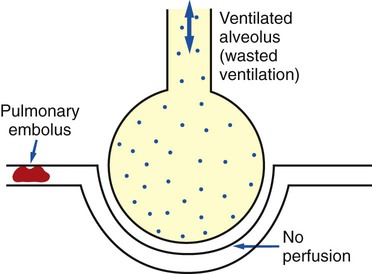

Dead space is the volume not taking part in gas exchange and, if increased, could affect alveolar ventilation if there is too low a delivered volume. Much of the air entering the enlarged airspaces cannot participate in gas exchange, which results in an increase in VDAlv. The surface area available for gas exchange is therefore reduced. The associated destruction of alveolar septa results in enlarged air spaces. Pulmonary artery obstruction by an embolus (arising from thrombus, gas, fat or amniotic fluid) results in the downstream alveoli being ventilated but not perfused, thus increasing VDAlv. In addition, the increase in intrathoracic pressure reduces venous return to the right ventricle, which in turn reduces pulmonary artery pressure. In the lung apices, the increase in alveolar pressure causes compression of the pulmonary capillaries, reducing alveolar perfusion. Positive end-expiratory pressure and positive pressure ventilation both increase alveolar pressure. Like upright posture, this leads to insufficient perfusion of the lung apices, a high V̇/ Q̇ ratio and thus an increase in VDAlv. Low pulmonary artery pressure for example, as a result of reduced right ventricular output. The apical alveoli are well ventilated but not adequately perfused, which increases VDAlv. Owing to the effect of gravity, blood only just perfuses the lung apices (i.e. However, VDAlv may increase as a result of: In normal lungs, VDAlv is negligible as alveolar ventilation and perfusion are well matched. 48) and VDAnat is measured using Fowler’s method. VDPhys is measured using the Bohr equation (see p. As VDPhys=VDAnat+VDAlv, the alveolar dead space can be calculated if VDPhys and VDAnat are known. How is alveolar dead space measured and what factors affect it?Īlveolar dead space cannot be measured directly.


 0 kommentar(er)
0 kommentar(er)
